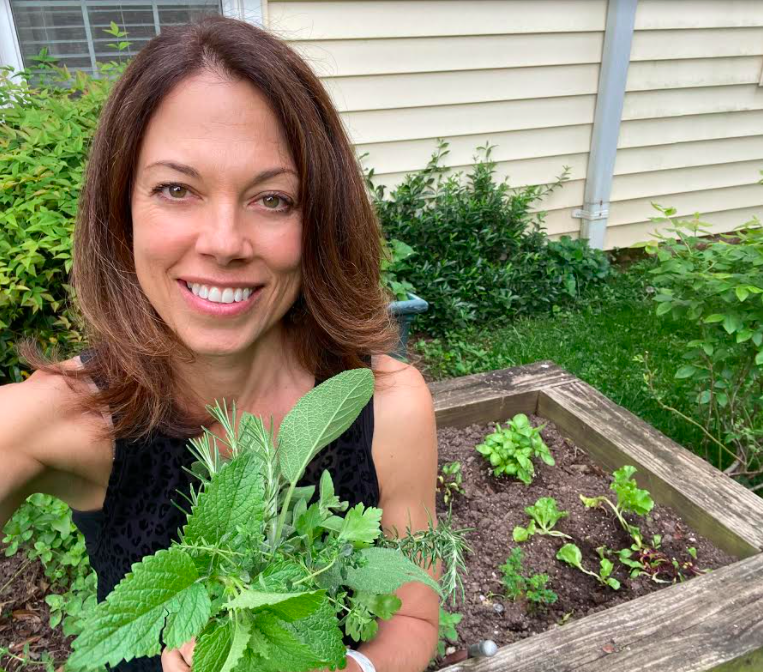Parsley, Sage, Rosemary & Thyme::
Culinary Herbs and Why We Should Be Eating Them
Michele Russ
“Eat your vegetables!” These words are spoken by countless parents at dinner tables everywhere. Vegetables are indeed an essential part of a healthy diet, adding vitamins, minerals and fiber that our bodies need to thrive. But did you know that culinary herbs are also full of nutrients? Growing up, we ate herbs infrequently and when we did have them, they were shaken out of a glass container; dried parsley on our potatoes, oregano in our spaghetti sauce and the occasional sprig of fresh parsley on our plates if we went out to a fancy dinner. In my mind, fresh herbs were just a colorful way to make a meal a little more special. Little did I know that those scattered flecks of green were packed with nutrients and just as nutritious as the vegetables on my plate. Michael Greger, physician and founder of NutritionFacts.org states that “ounce for ounce, herbs and spices have more antioxidants than any other food group.” I started growing a few herbs in pots years ago to add fresh flavors to meals, but this knowledge has prompted a whole new way of looking at these beautiful, fragrant plants.
Fresh and dried herbs have significant amounts of vitamins such as A, C and K. They also contain important minerals like iron, potassium, magnesium and even calcium. Additionally, herbs have polyphenols—plant compounds that are known to have antioxidant and anti-inflammatory properties which protect against disease. These wonderful little plants are amazing powerhouses of health!
I had so much fun last week planting the pots of culinary herbs with Hannah Sholder at Koiner Farm. You can watch the video here. It made me excited to plant more herbs in my garden this year than ever. I love being able to walk out my door, scissors in hand, to snip fresh, flavorful herbs when I’m cooking. Plus, they are so easy to grow, in the ground or in pots, even for me. Many herbs are perennials, which means they will grow back year after year (sage, thyme, rosemary). Others are annuals and have to be planted every year to grow (parsley, cilantro, dill).
Whether I buy fresh herbs at the grocery store or grow them in my garden, I am finding more ways to incorporate them into my diet for both flavor and nourishment. Here are some of my favorite ways to include them:
Add fresh parsley or basil leaves to wraps and sandwiches
Toss handfuls of fresh herbs into salads
Top potatoes with fresh chopped chives, parsley or rosemary
Add fresh herbs to your marinades
Make fresh pesto to serve on pasta
Add thyme, basil, parsley or oregano to pasta salads, quinoa or beans
Add handfuls of chopped herbs to soups and stews
Make homemade chimichurri sauce (See my favorite recipe below.)
Now that I know so much more about the nutrient density of fresh herbs, I find myself reaching for them more often. My meals have more complex, fresh flavors and I feel great about the healthy benefits I’m serving up. With what I’ve learned, perhaps someday instead of insisting that children eat their vegetables, we’ll be saying “Eat your herbs!”
Chimichurri Sauce
Goes well on steak, chicken, shrimp, scallops, potatoes and more.
1-2 Garlic Cloves, peeled
1 Large Bunch Fresh Parsley (cut off the bottom half of the stems)
2 T. Fresh Oregano, chopped (optional)
¼ tsp. Crushed Red Pepper Flakes
2 T. Red Wine Vinegar
⅓ c. Olive Oil
Salt to taste
Place garlic, parsley, oregano and red pepper flakes in a food processor. Pulse until finely chopped. Move to a bowl and add vinegar, olive oil and salt. Stir and serve generously.
Michele Russ is a certified Health & Wellness Coach, yoga teacher and is passionate about healthy living for all.


